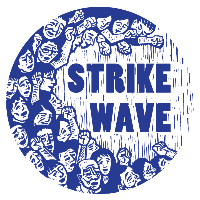Editorial: We need new leaders to fight for American workers.
by the Editors
Since news of Tefere Gebre’s suspension as Executive Vice President of the AFL-CIO broke earlier this month, the curtain around organized labor’s highest representative body has been peeled back. From explanations on how to chauffeur elected tribunes of the working-class, to deprioritization of new organizing, to allegations of failed leadership, it’s clear all is not well in the “House of Labor.”
Hypocrisy is nothing new to Richard Trumka’s AFL; the Washington Post carried stories of the AFL’s union-busting fight against the working people that clean Trumka’s office, and management infamously cleaned house with mass layoffs in early 2017.
Meanwhile, Trumka, President of the AFL-CIO since 2009, makes in excess of $300,000 in total compensation, according to filings with the Department of Labor. That’s not counting his chauffeur. It’s good work if you can get it.
Richard Trumka is a disgrace, but the problem is bigger than Trumka.
The ongoing ordeal involving the United Auto Workers’ and Fiat-Chrysler management kickbacks has been a slow-burning crisis for over a year, implicating individuals throughout the UAW’s highest ranks. John Coli of the International Brotherhood of Teamsters is set to plead guilty to extortion in a federal corruption probe, and a corruption probe into International Brotherhood of Electrical Workers Local 98 has implicated numerous officials including former Business Manager, Johnny “Doc” Dougherty.
Even in instances where no explicit corruption or graft exists—an absence which is, to be clear, the norm throughout labor—there is a real problem: pervasive leadership disconnected from the needs, experiences, and desires of a rank-and-file looking for increasingly militant action to fight against corporate greed and the 1%. In other words: leadership that is complacent and comfortable simply bargaining the terms of our exploitation, rather than fighting to end it.
Take the AFL, for example. Forty-six of the federation’s fifty-eight person Executive Council are men; in contrast, slightly less than half of all union members are women. A fraction of the Executive Council are persons of color. Many, like Trumka, were never actually rank-and-file members of the union—in fact, Trumka’s career started as a lawyer for the United Mine Workers’ of America. Two of labor’s most powerful leaders, Lee Saunders and Randi Weingarten, started as union economists and lawyers, respectively.
The old guard in organized labor—to say nothing of the “new labor” technocrats like Andy Stern, Dave Regan and David Rolf—have brought unions to a precipice from which we’re struggling to claw our way back. Their time is done; we won’t mourn its passing.
There are, to be clear, real leaders: leaders like Sara Nelson of the Association of Flight Attendants-CWA, who began her career as a rank-and-file flight attendant. Nelson is among the most electrifying leaders in the labor movement, embodying a style of leadership and action closely in tune with the needs and wants of the labor movement’s rank-and-file. Leaders like Kooper Caraway, of the Sioux Falls Central Labor Council, who is the second youngest Central Labor Council President in the country. Leaders like Alex Caputo-Pearl, President of the United Teachers’ of Los Angeles and countless others in Central Labor Councils, union locals, and on shop floors throughout the country.
These leaders and the rank-and-file movements they represent share a vision of a labor movement that wields the strength of organized workers in direct confrontation with the elite, rather than through transactional lobbying. The status quo got us to where we are. Now, we need to fight for something more.
Transforming labor will require forcing labor to organize new workers, to become the social movement embodied by militant campaigns like the Los Angeles teachers’ strike, and, in doing so, fight the bosses that dictate so much of our day-to-day lives. It’ll often require challenging ossified, entrenched leaderships more interested in defending their expense accounts than workers’ rights. Issuing that challenge means running insurgent candidates in every union local, Central Labor Council, Area Labor Federation, and State Federation across the country.
Central Labor Councils need to be more than social clubs and opportunities for Committee on Political Education (COPE) golf fundraisers. State Federations need to be more than lobbying shops and sinecures. And the AFL-CIO needs to lead with an eye solely on the interests of working people—without cozying up to the Beltway elite.
As we work to make this happen, the message to leadership should be clear: get on board, or get out of the way.
Unions are the only true representation of the interests of working people in America: they’re central forces fighting for progress. Organized labor has been at the heart of the most fundamental shifts of power away from the elite and toward working Americans and the exploited and dispossessed. Few true moments of progress have been won without the power of American workers.
That’s why we need to work for the unions we deserve—and not just accept the ones we have.

